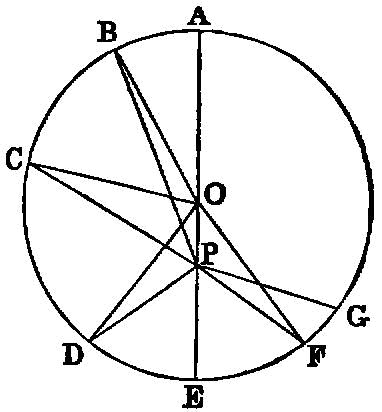Proposition 3.7

If on the diameter of a circle a point be taken which is not the centre of the circle, and from the point straight lines fall upon the circle, that will be greatest on which the centre is, the remainder of the same diameter will be least, and of the rest
the nearer to the straight line through the centre is always greater than the more remote, and only two equal straight lines will fall from the point on the circle, one on each side of the least straight line.
Let ABCD be a circle, and let AD be a diameter of it;
on AD let a point F be taken which is not the centre of the circle, let E be the centre of the circle, and from F let straight lines FB, FC, FG fall upon the circle ABCD; I say that FA is greatest, FD is least, and of the rest FB is
greater than FC, and FC than FG.
For let BE, CE, GE be joined.
Then, since in any triangle two sides are greater than the remaining one, [I. 20]
EB, EF are greater than BF.
But AE is equal to BE; therefore AF is greater than BF.
Again, since BE is equal to CE, and FE is common,
the two sides BE, EF are equal to the two sides CE, EF.
But the angle BEF is also greater than the angle CEF; therefore the base BF is greater than the base CF. [I. 24]
For the same reason CF is also greater than FG.
Again, since GF, FE are greater than EG, and EG is equal to ED, GF, FE are greater than ED.
Let EF be subtracted from each; therefore the remainder GF is greater than the remainder
FD.
Therefore FA is greatest, FD is least, and FB is greater than FC, and FC than FG.
I say also that from the point F only two equal straight lines will fall on the circle ABCD, one on each side of the
least FD.
For on the straight line EF, and at the point E on it, let the angle FEH be constructed equal to the angle GEF [I. 23], and let FH be joined.
Then, since GE is equal to EH,
and EF is common, the two sides GE, EF are equal to the two sides HE, EF; and the angle GEF is equal to the angle HEF;
therefore the base FG is equal to the base FH. [I. 4]
I say again that another straight line equal to FG will not
fall on the circle from the point F.
For, if possible, let FK so fall.
Then, since FK is equal to FG, and FH to FG, FK is also equal to FH, the nearer to the straight line through the centre being
thus equal to the more remote: which is impossible.
Therefore another straight line equal to GF will not fall from the point F upon the circle; therefore only one straight line will so fall.
Therefore etc. Q. E. D.
